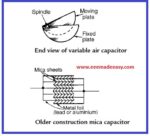The two poles of the stator winding are connected to each other so that the AC voltages are in phase, so they add.
Also Read : Synchronous Machines|synchronous generator & synchronous Motor
As the rotor (field) turns, its poles will induce AC voltages in the stator (armature) windings.
Since one rotor pole is in the same position relative to a stator pole as any other rotor pole, both the stator poles are cut by equal amounts of magnetic lines of force at any time. As a result, the voltages induced in the two poles of the stator winding have the same amplitude or value at any given instant.
Read Also :Three-phase alternator|3 phase Synchronous Generator
- Read Here Synchronous machines notes and MCQs
- Read about Synchronous Machines
- Construction of Synchronous Machines
- Read Here Electrical and Mechanical Degrees in Synchronous Machines
- Synchronous Machines Advantages and disadvantages
- Parallel operations of Alternators
- Synchronous machines MCQ 3
- Synchronous machines MCQ 2
- Synchronous machines MCQ 1
- Single phase alternator|Synchronous Generator
- Three-phase alternator|3 phase Synchronous Generator
Latest Posts in EEE Made Easy
- RRB JE CBT 2 Exam Date 2025 Postponed|RRB JE CBT 2 Exam Date
- [PDF]RRB JE Result 03/2024 Cut off, Selected no of candidates for all regions
- [PDF]Final Answer Key Junior Instructor Mechanic Agricultural Machinery|643/2023 Solved Question paper
- Acoustics MCQs|Industries Extension officer|IEO 2025
- LASER MCQs| Industries Extension officer|IEO 2025
- Practical Types of Capacitors
- [PDF] Syllabus JUNIOR INSTRUCTOR MECHANIC AGRICULTURAL MACHINERY|643/2023 Syllabus Kerala PSC



